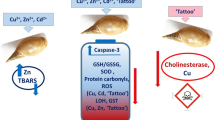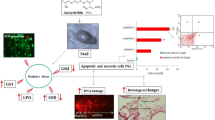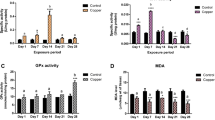Abstract
Acrylamide (ACR) is a widespread industrial chemical with recognized adverse effects not only to humans but to other organisms in the environment as well. In the present study, the ecotoxicological effects of dietary exposure to sublethal concentration (1/20 LC50) of ACR on the land snail, Theba pisana after 2 weeks of exposure and 1-week recovery with respect to oxidative stress parameters; lipid peroxidation (LPO), reduced glutathione (GSH), catalase (CAT), and glutathione-S-transferase (GST), cytogenetic parameter; deoxyribonucleic acid (DNA) content, as well as immunological parameters; cell death, phagocytosis, lysosomal membrane stability (LMS), lectins, superoxide anion (O2−) generation, phenoloxidase (PO), peroxidase (POD), and hemocyanin (Hc) were examined. The results showed that ACR significantly increased LPO level and the activity of CAT and GST, cell death, and Hc level, whereas a significant decline in DNA and GSH contents, phagocytic activity, LMS, lectins, O2− generation, POD, and PO activities compared to the controls after 2-week exposure was observed. After 1-week recovery, most of the tested parameters in exposed snails were permanent and not reversible to the control levels. This study suggests that the tested multiple parameters of T. pisana species may be used as biomarkers of ACR exposure. Besides, T. pisana snails could be used as a good sentinel organism for ACR exposure in pollution monitoring studies.



Similar content being viewed by others
References
Adema CM, Arguello DF, Stricker SA, Loker ES (1994) A time-lapse study of interactions between Echinostoma paraensei intramolluscan larval stages and adherent hemocytes from Biomphalaria glabrata and Helix aspersa. J Parasitol 80:719–727
Ali D (2014) Oxidative stress-mediated apoptosis and genotoxicity induced by silver nanoparticles in freshwater snail Lymnaea luteola L. Biol Trace Elem Res 162:333–341
Ashida M, Ohnishi E (1967) Activation of pre-phenol oxidase in hemolymph of the silkworm. Arch Biochem Biophys 122:411–416
Auffreta M, Rousseaua S, Bouteta I, Tanguya A, Baronb J, Moragaa D, Duchemina M (2006) A multiparametric approach for monitoring immunotoxic responses in mussels from contaminated sites in Western Mediterranean. Ecotoxicol Environ Saf 63:393–405
Bakunina N, Pariante CM, Zunszain PA (2015) Immune mechanisms linked to depression via oxidative stress and neuroprogression. Immunology 144:365–373
Baunthiyal M, Singh V, Dwivedi S (2017) Insights of antioxidants as molecules for drug discovery. Int J Pharmacol 13:874–889
Beers RF Jr, Sizer IW (1952) Spectrophotometric method for measuring the breakdown of hydrogen peroxide by catalase. J Biol Chem 195:133–140
Bislimi K, Behluli A, Halili J, Mazreku I, Halili F (2013) Impact of pollution from Kosova’s power plantin obiliq on some biochemical parameters of the local population of garden snail (Helix pomatia L.). Res Environ 3:15–19
Buczek SB, Gregory Cope W, Mclaughlin RA, Kwak TJ (2017) Acute toxicity of polyacrylamide flocculants to early life stages of freshwater mussels. Environ Toxicol Chem 36:2715–2721
Calisi A, Lionetto MG, Giordano ME, Schettino T (2008) Morphometric alterations in Mytilus galloprovincialis granulocytes: a new biomarker. J Environ Toxicol Chem 27:1435–1441
Calisi A, Lionetto MG, Schettino T (2011) Biomarker response in the earthworm Lumbricus terrestris exposed to chemical pollutants. Sci Total Environ 409:4456–4464
Chance B, Maehly AC (1955) Methods of Enzymology 2:773–775
Cheng W, Wang LU, Chen JC (2005) Effect of water temperature on the immune response of white shrimp Litopenaeus vannamei to Vibrio alginolyticus. Aquaculture 250:592–601
CoStat program (2002) Microcomputer program analysis. CoHort software, Version 2.6, Monterey
Costa R, Pereira JL, Gomes J, Gonçalves F, Hunkeler D, Rasteiro MG (2014) The effects of acrylamide polyelectrolytes on aquatic organisms: relating toxicity to chain architecture. Chemosphere 112:177–184
De Vaufleury A, Coeurdassier M, Pandard P, Scheifler R, Lovy C, Crini N, Badot P-M (2006) How terrestrial snails can be used in risk assessment of soils. Environ Toxicol Chem 25:797–806
Dyrynda EA, Pipe RK, Burt GR, Ratcliffe NA (1998) Modulations in the immune defences of mussels (Mytilus edulis) from contaminated sites in the UK. Aquat Toxicol 42:169–185
El-Gendy KS, Radwan MA, Gad AF (2011) Feeding and growth responses of the snail Theba pisana to dietary metal exposure. Arch Environ Contam Toxicol 60:272–280
El-Gendy KS, Radwan MA, Gad AF, Khamis AE, Eshra EH (2019a) Physiological traits of land snails Theba pisana as simple endpoints to assess the exposure to some pollutants. Environ Sci Pollut Res 26: In Press. https://doi.org/10.1007/s11356-019-04180-8
El-Gendy KS, Radwan MA, Gad AF, Khamis AE, Eshra EH (2019b) Use of multiple endpoints to investigate the ecotoxicological effects of abamectin and thiamethoxam on Theba pisana snails. Ecotoxicol Environ Saf 167:242–249
Fourie F, Reinecke SA, Reinecke AJ (2007) The determination of earthworm species sensitivity differences to cadmium genotoxicity using the comet assay. Ecotox Environ Saf 67:361–368
Friedman M (2003) Chemistry, biochemistry, and safety of acrylamide. A Review. J Agric Food Chem 51:4504–4526
Gad AF, Radwan MA, EL-Gendy KS, Eshra EH, Seehy MA, Khamis A (2016) Genotoxic potential of some pollutants in Theba pisana snails using the micronucleus test. Inter J Zool Invest 2: 197–205
Galloway TS, Depledge MH (2001) Immunotoxicity in invertebrates: measurement and ecotoxicological relevance. Ecotoxicology 10:5–23
Galloway TS, Sanger RC, Smith KL, Fillman G, Readman JW, Ford TE, Depledge MH (2002) Rapid assessment of marine pollution using multiple biomarkers and chemical immunoassays. Environ Sci Technol 36:2219–2226
Ghorbel I, Maktouf S, Kallel C, Ellouze Chaabouni S, Boudawara T, Zeghal N (2015) Disruption of erythrocyte antioxidant defence system, hematological parameters, indication of pro-inflammatory cytokines and DNA damage in liver of co-exposed rats to aluminium and acrylamide. Chem Biol Interact 236:31–40
Guezennec AG, Michel C, Bru K, Touze S, Desroche N, Mnif I, Motelica-Heino M (2015) Transfer and degradation of polyacrylamide-based flocculants in hydrosystems: a review. Environ Sci Pollut Res 22:6390–6406
Itziou A, Dimitriadis VK (2011) Introduction of the land snail Eobania vermiculata as a bioindicator organism of terrestrial pollution using a battery of biomarkers. Sci Total Environ 409:1181–1192
Krautter GR, Mast RW, Alexander HC, Thompson CM (1986) Acute toxicity tests with acrylamide monomer and macroinvertebrates and fish. Environ Toxicol Chem 5:373–377
Krishna G, Muralidhara (2015) Inulin supplementation during gestation mitigates acrylamide-induced maternal and fetal brain oxidative dysfunctions and neurotoxicity in rats. Neurotoxicol Teratol 49:49–58
Larguinho M, Cordeiro A, Diniz MS, Costa PM, Baptista PV (2014) Metabolic and histopathological alterations in the marine bivalve Mytilus galloprovincialis induced by chronic exposure to acrylamide. Environ Res 135:55–62
Li X, Liu H, Lv L, Yan H, Yuan Y (2018) Antioxidant activity of blueberry anthocyanin extracts and their protective effects against acrylamide-induced toxicity in HepG2 cells. Int J Food Sci Technol 53:147–155
Lowry OH, Rasebrough NJ, Farr AL, Randall RJ (1951) Protein measurement with the folin phenol reagent. J Biol Chem 193:265–275
Maity S, Roy S, Chaudhury S, Bhattacharya S (2008) Antioxidant responses of the earthworm Lampito mauritii exposed to Pb and Zn contaminated soil. Environ Pollut 151:1–7
Nair V, Turner GE (1984) The thiobarbituric acid test for lipid peroxidation: structure of the adduct with malondialdehyde. Lipids 19:804–805
Negrão-Corrêa D, Pereira CAJ, Rosa FM, Martins-Souza RL, Andrade ZA, Coelho PMZ (2007) Molluscan response to parasite, Biomphalaria and Schistosoma mansoni interaction. Invertebr Surviv J 4:101–111
Olafsen JA (1996) Lectins: models of natural and induced molecules in invertebrates. In: Cooper EL (Ed) Advances in Comparative and Environmental Physiology: invertebrate immune responses, cell activities and the environment. 24: 49–76
Owens WI, Belcher RV (1965) A colorimetric micro-method for the determination of glutathione. Biochem J 94:705–711
Palmer CV, Bythell JC, Willis BL (2010) Levels of immunity parameters underpin bleaching and disease susceptibility of reef corals. FASEB J 24:1935–1946
Pipe RK (1992) Generation of reactive oxygen metabolites by the haemocytes of the mussel Mytilus edulis. Dev Comp Immunol 16:111–122
Pipe RK, Coles JA (1995) Environmental contaminants influencing immune function in marine bivalve molluscs. Fish Shellfish Immunol 5:581–595
Pipe RK, Coles JA, Farley SR (1995) Assays for measuring immune response in the mussel Mytilus edulis. Tech. Fish Immunol 4:93–100
Pipe RK, Coles JA, Carissan FMM, Ramanathan K (1999) Copper induced immunomodulation in the marine mussel, Mytilus edulis. Aqua Toxicol 46:43–54
Prased SN, Muralidhara (2012) Evidence of acrylamide induced oxidative stress and neurotoxicity in Drosophila melanogaster - its amelioration with spice active enrichment: relevance to neuropathy. NeuroToxicol. 33:1254–1264
Radwan MA, El-Gendy KS, Gad AF (2010a) Biomarkers of oxidative stress in the land snail, Theba pisana for assessing ecotoxicological effects of urban metal pollution. Chemosphere 79:40–46
Radwan MA, El Gendy KS, Gad AF (2010b) Oxidative stress biomarkers in the digestive gland of Theba pisana exposed to heavy metals. Arch Environ Contam Toxicol 58:828–835
Rahmankulova, Kopteva (1976) Kliniceskaja biohimija, Belarus kn. Minsks 7:218
Rajeh N, Hamdy A, El-Assoli S (2014) Protective effect of 5-aminosalicylic acid on acrylamide toxicity in the testis and blood leukocytes of the rat. Kuwait Med J 46:32–43
Raju J, Sondagar C, Roberts J, Aziz SA, Caldwell D, Vavasour E, Mehta R (2011) Dietary acrylamide does not increase colon aberrant crypt foci formation in male F344 rats. Food Chem Toxicol 49:1373–1380
Rank J, Jensen K (2003) Comet assay on gill and hemocytes from the blue mussel Mytilus edulis. Ecotoxicol Environ Saf 54:323–329
Ratcliffe NA, Nigam Y, Mello CB, Garcia ES, Azambuja P (1996) Trypanosoma cruzi erythrocyte agglutinins: a comparative study of occurance and properties in the gut and hemolymph of Rhodnius prolixus. Exp Parasitol 83:83–93
Regoli F, Gorbi S, Fattorini D, Tedesco S, Notti A, Machella N, Bocchetti R, Benedetti M, Piva F (2006) Use of the land snail Helix aspersa as sentinel organism for monitoring ecotoxicologic effects of urban pollution: an integrated approach. Environ Health Persp 114:63–69
Rockett JC, Kim SJ (2005) Biomarkers of reproductive toxicity. Cancer Biomarkers 1:93–108
Rodríguez-Eugenio N, McLaughlin M, Pennock D (2018) Soil pollution: a hidden reality. Rome, FAO 142 pp.
Russo J, Madec L (2007) Haemocyte apoptosis as a general cellular immune response of the snail, Lymnaea stagnalis, to a toxicant. Cell Tissue Res 328:431–441
Snyman RG, Reinecke AJ, Reinecke SA (2002) Field application of a lysosomal assay as biomarker of copper oxychloride exposure, in the snail Helix aspersa. Bull Environ Contam Toxicol 69:117–122
Soderhall K, Cerenius L, Johansson MW (1996) The prophenoloxidase activating system in invertebrates. In: Soderhall K, Iwanaga S, Vasta GR (eds) New directions in invertebrate immunology. SOS Publications, Fair Haven, pp 229–253
Subaraja M, Vanisree AJ (2015) Cerebral ganglionic variations and movement behaviors of Lumbricus terrestris on exposure to neurotoxin. Ann Neurosci 22(4):199–207
Suresh K, Mohandas A (1990) Hemolymph acid phosphatase activity pattern in copper-stressed bivalves. J Invert Pathol 55:118–125
Uliasz TF, Hewett SJ (2000) A microtiter trypan blue absorbance assay for quantitative determination of excitoxic neuronal injury in cell culture. J Neurosci Methods 100:157–163
Van der Oost R, Beyer J, Vermeulen NPE (2003) Fish bioaccumulation and biomarkers in environmental risk assessment: a review. Environ Toxicol Phar 13:57–149
Vessey DA, Boyer TD (1984) Differential activation and inhibition of different forms of rat liver glutathione S-transferase by the herbicides 2,4-dichloro phenoxy acetate (2,4-D) and 2,4,S trichloro phenoxy acetate (2,4, S-T). Toxicol Appl Pharmacol 73:492–499
Yousef MI, El-Demerdash FM (2006) Acrylamide-induced oxidative stress and biochemical perturbations in rats. Toxicology 219:133–141
Funding
The author(s) received no financial support for the research, authorship, and/or publication of this article.
Author information
Authors and Affiliations
Corresponding author
Ethics declarations
Conflict of interest
The authors declare that they have no conflict of interest.
Additional information
Responsible editor: Philippe Garrigues
Publisher’s note
Springer Nature remains neutral with regard to jurisdictional claims in published maps and institutional affiliations.
Rights and permissions
About this article
Cite this article
Radwan, M.A., El-Gendy, K.S., Gad, A.F. et al. Ecotoxicological biomarkers as investigating tools to evaluate the impact of acrylamide on Theba pisana snails. Environ Sci Pollut Res 26, 14184–14193 (2019). https://doi.org/10.1007/s11356-019-04784-0
Received:
Accepted:
Published:
Issue Date:
DOI: https://doi.org/10.1007/s11356-019-04784-0




